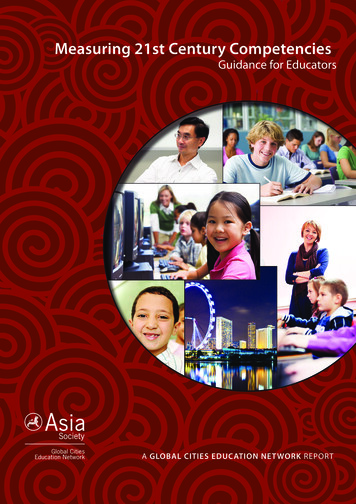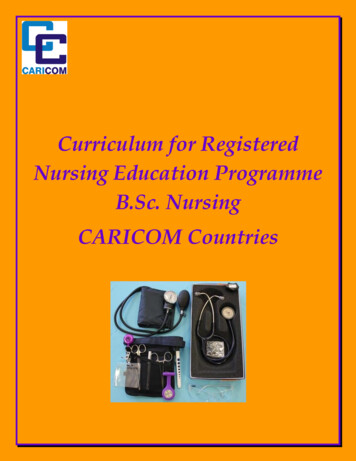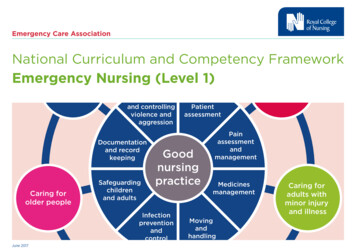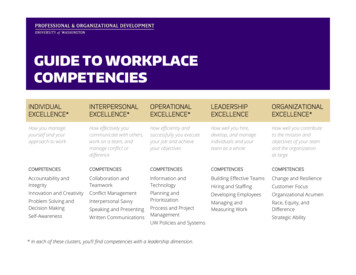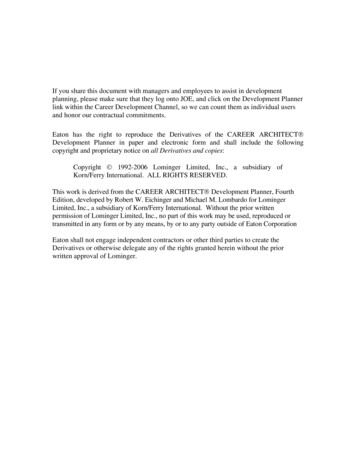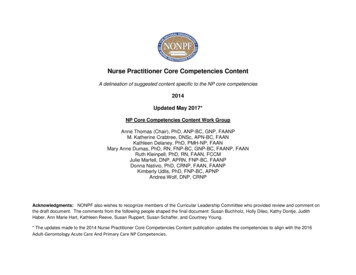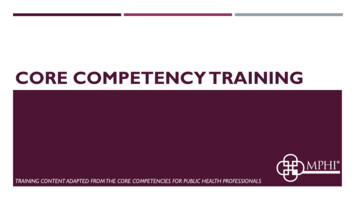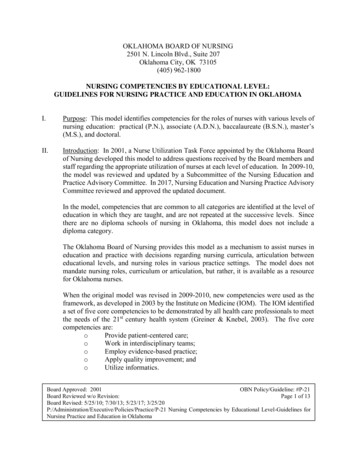
Transcription
OKLAHOMA BOARD OF NURSING2501 N. Lincoln Blvd., Suite 207Oklahoma City, OK 73105(405) 962-1800NURSING COMPETENCIES BY EDUCATIONAL LEVEL:GUIDELINES FOR NURSING PRACTICE AND EDUCATION IN OKLAHOMAI.Purpose: This model identifies competencies for the roles of nurses with various levels ofnursing education: practical (P.N.), associate (A.D.N.), baccalaureate (B.S.N.), master’s(M.S.), and doctoral.II.Introduction: In 2001, a Nurse Utilization Task Force appointed by the Oklahoma Boardof Nursing developed this model to address questions received by the Board members andstaff regarding the appropriate utilization of nurses at each level of education. In 2009-10,the model was reviewed and updated by a Subcommittee of the Nursing Education andPractice Advisory Committee. In 2017, Nursing Education and Nursing Practice AdvisoryCommittee reviewed and approved the updated document.In the model, competencies that are common to all categories are identified at the level ofeducation in which they are taught, and are not repeated at the successive levels. Sincethere are no diploma schools of nursing in Oklahoma, this model does not include adiploma category.The Oklahoma Board of Nursing provides this model as a mechanism to assist nurses ineducation and practice with decisions regarding nursing curricula, articulation betweeneducational levels, and nursing roles in various practice settings. The model does notmandate nursing roles, curriculum or articulation, but rather, it is available as a resourcefor Oklahoma nurses.When the original model was revised in 2009-2010, new competencies were used as theframework, as developed in 2003 by the Institute on Medicine (IOM). The IOM identifieda set of five core competencies to be demonstrated by all health care professionals to meetthe needs of the 21st century health system (Greiner & Knebel, 2003). The five corecompetencies are:oProvide patient-centered care;oWork in interdisciplinary teams;oEmploy evidence-based practice;oApply quality improvement; andoUtilize informatics.Board Approved: 2001OBN Policy/Guideline: #P-21Board Reviewed w/o Revision:Page 1 of 13Board Revised: 5/25/10; 7/30/13; 5/23/17; ce/P-21 Nursing Competencies by Educational Level-Guidelines forNursing Practice and Education in Oklahoma
These competencies are defined in Section III below.In the revisions completed in 2017, the Essentials of Baccalaureate Education forProfessional Nursing Practice (2008), The Essentials of Master’s Education In Nursing(2011), and The Essentials of Doctoral Education for Advanced Nursing Practice (2006),published by the American Association of Colleges of Nursing, were used as keyreferences for revising sections related to baccalaureate and master’s level education, aswell as for adding a new section on doctoral education. However, because master’s anddoctoral nursing education prepares nurses for other roles besides advanced practice,sections that focused on general competencies for all master’s- or doctorally-preparednurses were used. A sub-committee comprised of volunteers from the Nursing Educationand Nursing Practice Advisory Committee met in November 2016 to further review anddiscuss Safety as a stand-alone competency. The current document reflects proposedchanges recommended by the sub-committee and approved by the Nursing Education andNursing Practice Advisory Committee in February 2017. References are identified inSection #V.III.DefinitionsApplying Quality Improvement: Identifying errors and hazards in care; understandingand implementing basic safety design principles, such as standardization andsimplification; continually understanding and measuring quality of care in terms ofstructure, process, and outcomes in relation to patient and community needs; designing andtesting interventions to change processes and systems of care, with the objective ofimproving quality.Clients: The term “clients” is used in this document to describe the recipients of nursingcare. Clients for licensed practical and associate degree nurses include individuals,families and groups. Clients for baccalaureate nurses include individuals, families, groupsand communities. Clients for nurses prepared at the master’s level include individuals,families, groups, communities and populations.Competence: “The application of knowledge and the interpersonal, decision-making andpsychomotor skills expected for the practice role, within the context of public health,safety, and welfare” (NCSBN, retrieved on 12/9/2019 from https://www.ncsbn.org/).Employing Evidence-Based Practice: Integrating best research with clinical expertiseand patient values for optimum care, and participating in learning and research activitiesto the extent feasible.Board Approved: 2001OBN Policy/Guideline: #P-21Board Reviewed w/o Revision:Page 2 of 13Board Revised: 5/25/10; 7/30/13; 5/23/17; ce/P-21 Nursing Competencies by Educational Level-Guidelines forNursing Practice and Education in Oklahoma
Essentials of Baccalaureate Nursing Education, as defined by AACN (2008):1.Liberal education for baccalaureate generalist nursing practice2.Basic organizational and systems leadership for quality care and patient safety3.Scholarship for evidence-based practice4.Information management and application of patient care technology5.Health care policy, finance, and regulatory environments6.Interprofessional communication and collaboration for improving patient healthoutcomes7.Clinical prevention and population health8.Professionalism and professional values9.Baccalaureate generalist nursing practiceEssentials of Master’s Education in Nursing, as defined by AACN (2011):1.Background for Practice from Sciences and Humanities2.Organizational and Systems Leadership3.Quality Improvement and Safety4.Translating and Integrating Scholarship into Practice5.Informatics and Healthcare Technologies6.Health Policy and Advocacy7.Interprofessional Collaboration for Improving Patient and Population HealthOutcomes8.Clinical Prevention and Population Health for Improving Health9.Master’s Level Nursing PracticeEssentials of Doctoral Education for Advanced Nursing Practice (AACN, 2006):1.Scientific underpinnings for practice2.Organizational and systems leadership for quality improvement and systemsthinking3.Clinical scholarship and analytical methods for evidence-based practice4.Information systems/technology and patient care technology for the improvementand transformation of health care5.Health care policy for advocacy in health care6.Inter-professional collaboration for improving patient and population healthoutcomes7.Clinical prevention and population health for improving the nation’s health8.Advanced Nursing PracticeNursing: “The practice of nursing means the performance of services provided forpurposes of nursing diagnosis and treatment of human responses to actual or potentialhealth problems consistent with educational preparation. Knowledge and skill are the basisfor assessment, analysis, planning, intervention, and evaluation used in the promotion andmaintenance of health and nursing management of illness, injury, infirmity, restoration orBoard Approved: 2001OBN Policy/Guideline: #P-21Board Reviewed w/o Revision:Page 3 of 13Board Revised: 5/25/10; 7/30/13; 5/23/17; ce/P-21 Nursing Competencies by Educational Level-Guidelines forNursing Practice and Education in Oklahoma
optimal function, or death with dignity. Practice is based on understanding the humancondition across the human lifespan and understanding the relationship of the individualwithin the environment. This practice includes execution of the medical regime includingthe administration of medications and treatments prescribed by any person authorized bystate law to so prescribe.” [Title 59 O.S. §567.3a.2].Providing Patient-Centered Care: Identifying, respecting and caring about patients’differences, values, preferences, and expressed needs; relieving pain and suffering;coordinating continuous care; listening to, clearly informing, communicating with, andeducating patients; sharing decision making and management; and continuouslyadvocating disease prevention, wellness, and promotion of healthy lifestyles, including afocus on population health.Safety: Minimizing the risk of harm to patients and providers through both systemeffectiveness and individual performance.Utilizing Informatics: Communicating, managing knowledge, mitigating error, andsupporting decision making using information technology.Working in Interdisciplinary Teams: Cooperating, collaborating, communicating, andintegrating care in teams to ensure that care is continuous and reliable.IV.Regulatory Authority: 59 O.S. §567.2a.1V.ReferencesAmerican Association of Colleges of Nursing. (2008) The Essentials of BaccalaureateEducation for Professional Nursing Practice. Retrieved December 9, 2019, entials08.pdfAmerican Association of Colleges of Nursing. (2006) The Essentials of DoctoralEducation for Advanced Nursing Practice. Retrieved December 9, 2019, fAmerican Association of Colleges of Nursing. (2011) The Essentials of Master’sEducation In Nursing. Retrieved December 9, 2019, astersEssentials11.pdfGreiner, A. & Knebel, E. (Eds.) (2003) Health Professions Education: A Bridge to Quality.Institute of Medicine of the National Academy of Sciences: Washington, D.C.Board Approved: 2001OBN Policy/Guideline: #P-21Board Reviewed w/o Revision:Page 4 of 13Board Revised: 5/25/10; 7/30/13; 5/23/17; ce/P-21 Nursing Competencies by Educational Level-Guidelines forNursing Practice and Education in Oklahoma
National Federation of Licensed Practical Nurses. (2003). NFLPN Nursing PracticeStandards for the Licensed Practical/Vocational Nurses.National Association for Practical Nurse Education and Service. (2007). NAPNESStandards of Practice and Educational Competencies of Graduates ofPractical/Vocational Nursing Programs.Oklahoma Nursing Practice Act, Title 59, Oklahoma Statute Chapter 12, §§ 567.1 et seq.(2019).Quality and Safety Education for Nurses National Advisory Board. (n.d.). Quality andSafety Education for Nurses: Pre-Licensure and Graduate Knowledge, Skills, andAttitudes. Retrieved December 9, 2019, fromhttp://qsen.org/competencies/Board Approved: 2001OBN Policy/Guideline: #P-21Board Reviewed w/o Revision:Page 5 of 13Board Revised: 5/25/10; 7/30/13; 5/23/17; ce/P-21 Nursing Competencies by Educational Level-Guidelines forNursing Practice and Education in Oklahoma
NURSING COMPETENCIES BY EDUCATIONAL LEVELROLESCaregiverAdvocateTeacherCOMPETENCY #1: PROVIDING CLIENT-CENTERED CAREPNADNBSNMASTERSAssists in theUses concepts fromUses scientific andUses specializedimplementation ofnursing and othernursing knowledgeknowledge and expertiseestablished plans of care disciplines to plan,(including currentto influence, design,for clients. Providescoordinate, implement,evidence from nursing coordinate, implement,client- centered careand evaluate nursing care research) to plan,and evaluatewith sensitivity,designed to promote,coordinate, implement, comprehensive, integratedempathy and respect for restore, and/or maintain and evaluate nursingcare to increasinglythe diversity of humanoptimal outcomes.care for clients in acomplex, diverseexperience.variety of settings.populations in multipleenvironments across thelifespan.Protects the health,Uses knowledge ofActively engages inUses knowledge and skillssafety and rights of the consumers’policy processesto promote health andclient.rights/responsibilitiesdefining healthcareshape the healthcareand health policy to plan delivery and systems of delivery system throughcare and intervene oncare in order to support healthcare policybehalf of clients.the client’sdevelopment.participation inhealthcare decisions.Provides basic healthDevelops, implements,Uses theoreticalUses advanced theoreticalteaching for clients,and evaluates teachingknowledge andknowledge, teachingusing establishedplans for clients usingcommunication skillsprinciples, and teachingteaching plans.evidence-based practice. to develop, coordinate, strategies to design,implement andcoordinate, implement,evaluate clientand evaluatecentered teachingcomprehensive teachingplans.programs for multipleenvironments.DOCTORATEAdvances situationalexposure and evidencebased practice to prepare,plan, or implement clientcare. Uses advancedknowledge to developcare delivery models,health policies, andpractice guidelines.Designs, develops, andeducates others regardinghealthcare policies.Organizes policies so thatthey are easily accessibleand useful.Plans, designs,implements, evaluates,and organizes teachingprograms for clients.Board Approved: 2001OBN Policy/Guideline: #P-21Board Reviewed w/o Revision:Page 6 of 13Board Revised: 5/25/10; 7/30/13; 5/23/17; ce/P-21 Nursing Competencies by Educational Level-Guidelines for Nursing Practice and Education in Oklahoma
COMPETENCY #1: PROVIDING CLIENT-CENTERED terpersonal andrelationships.and educates clientsrelationships andtherapeuticand other caregiverscounseling strategies.communication skills;about health, wellness,observing clientand diseaseconfidentiality andmanagement andprofessional boundaries.prevention.Uses critical thinking and Uses current evidence Uses acquired knowledgeDecision Maker Uses problem-solvingskills to make decisions research-basedfrom nursing andand skills to challengeand prioritize basicinformatics as a basis for healthcare research to assumptions and effecthealth care needs.responding to changes in evaluate healthcarechange in practice andhealth care needs.needs and improve the s bodies ofknowledge for planning,designing, implementing,and evaluatingtherapeutic relationshipsand counseling strategies.Uses clinical scholarshipand analytical methodsfor evidence basedpractice and clinicalprevention. Analyzespopulation health tovalidate decisions andtrends regarding thenation’s health.Board Approved: 2001OBN Policy/Guideline: #P-21Board Reviewed w/o Revision:Page 7 of 13Board Revised: 5/25/10; 7/30/13; 5/23/17; ce/P-21 Nursing Competencies by Educational Level-Guidelines for Nursing Practice and Education in Oklahoma
ROLESCollaboratorManagerFacilitatorCOMPETENCY #2: WORK IN INTERDISCIPLINARY TEAMSADNBSNMASTERSShares anParticipates in collegialEstablishes, promotes Establishes and evaluatesinterdependentrelationships for theand evaluates the care professional networks forrelationship with otherpurpose of establishingenvironment for thethe purpose of improvinghealth care teamcontinuity of care.purpose of improving client outcomes whilemembers for theclient outcomes while utilizing theory to addresspurpose of improvingpromoting civility and complex issues and designclient outcomes.an environment ofcare to meet the needs ofsafety for diversemultiple populations.individuals.Supervises careCollaborates inAssumes a positiveDelegates and directsprovided by unlicensed coordination of human,role in planning,nursing team resourcesassistants.informatics, and material coordinating,(human and fiscal) inresources in structuredorganizing, andcollaboration with thesettings. Manages small evaluating the effective team.groups of caregivers inuse of human, fiscal,structured settings.and physical resourceswithin the healthcareenvironment.Participates in groupUses knowledge of group Uses group concepts to Advances group efforts toprocess to promote the dynamics to improvedevelop animprove care throughprovision of nursingclient outcomes.environment focusedintegration of scientificcare.on qualityfindings from multipleimprovement, safetydisciplines to provideand accountability.quality care to multiplepopulations.PNDOCTORATEUses inter-professionalcollaboration, for thepurpose of improvingclient and populationhealth outcomes.Uses organizational andleadership skills inquality improvement andsystems thinking, for thepurpose of improvingclient and populationhealth outcomes throughmanagement of care.Uses organizational andleadership skills inindividual and groupfacilitation, for thepurpose of improvingclient and populationhealth outcomes.Board Approved: 2001OBN Policy/Guideline: #P-21Board Reviewed w/o Revision:Page 8 of 13Board Revised: 5/25/10; 7/30/13; 5/23/17; ce/P-21 Nursing Competencies by Educational Level-Guidelines for Nursing Practice and Education in Oklahoma
ROLESEthicistCOMPETENCY #2: WORK IN INTERDISCIPLINARY TEAMSPNADNBSNMASTERSComplies with theAnticipates andUses the ethicalUses ethical analysis andethical, legal, andcontributes to the ethical decision-makingclinical reasoning toregulatory frameworks decision-making process. process to examineinfluence health careof nursing and the scope Participates within legal potential ethicalpractices. Usesof practice that isboundaries as asituations and resolveadditional knowledge andconsistent with thecontributing member toethical dilemmas.clinical expertise toOklahoma Nursingthe profession andresolve ethical dilemmas.Practice Act.advancement of nursing.Incorporates moralconcepts and respect fordiverse values andbeliefs. Identifies andcommunicates ethicaldilemmas.DOCTORATEFunctions as a keymember of IRBcommittees for thepurpose of ethicalresearch understanding.Uses health care policyfor advocacy in healthcare.Board Approved: 2001OBN Policy/Guideline: #P-21Board Reviewed w/o Revision:Page 9 of 13Board Revised: 5/25/10; 7/30/13; 5/23/17; ce/P-21 Nursing Competencies by Educational Level-Guidelines for Nursing Practice and Education in Oklahoma
ROLESScholarResearcherCOMPETENCY #3: EMPLOY EVIDENCE-BASED PRACTICEPNADNBSNMASTERSMaintains competenceIncorporates professional Uses research findings Commits to evidenceand professional growth development to improve and other evidence tobased practice to improvethrough life-longhealth care and advance provide multihealth care and advancelearning.the profession.dimensional, highthe profession whilequality, and costpromoting life longeffective care in alearning and criticalchanging environment. thinking in all.Participates in collecting Participates in researchEvaluates researchContributes clinicalclient outcomes data.team activities and uses reports, using currentexpertise to create ainterpreted nursingstandards, to determine climate in the practiceresearch findings toappropriateness forsetting that supportsimprove client care andutilization in clinicalscholarly inquiry,client safety.practice. Functions as evidence-based practice,a team member inand scientificfacilitating researchinvestigation. Providesprojects. Sharesleadership for designingevidence of bestresearch and integratingpractices with interfindings in health careprofessional team.practice.DOCTORATEDisseminates findingsand informationelectronically, and bypublication and oralpresentation whenapplicable.Develops, transmits,applies, and organizesresearch methodologiesas applicable for specificclinical settings.Board Approved: 2001OBN Policy/Guideline: #P-21Board Reviewed w/o Revision:Page 10 of 13Board Revised: 5/25/10; 7/30/13; 5/23/17; ce/P-21 Nursing Competencies by Educational Level-Guidelines for Nursing Practice and Education in Oklahoma
ROLESSafetyCOMPETENCY #4: SAFETYPNADNBSNParticipates as a teamUses nationallyEvaluates themember inrecognized safetyhealthcareimplementing nationally standards for client care, environment, systemsrecognized safetystaff scheduling, andof care and client andstandards to reduce risk regulation of work flow. community needsof harm to self andReports errors andwithin the context ofothers. Reports errorssupports members of the nationally recognizedand supports membershealth care team to besafety standards.of the health care team forthcoming about errors Reports errors andto be forthcoming about and near misses.supports members oferrors and near misses.the health care team tobe forthcoming abouterrors and near misses.MASTERSArticulates methodology,tools, performancemeasures and standards asthey relate to safety.Reports errors andsupports members of thehealth care team to beforthcoming about errorsand near misses.DOCTORATEOrganizes bodies ofknowledge to design safepractice guidelines.Reports errors andsupports members of thehealth care team to beforthcoming about errorsand near misses.Board Approved: 2001OBN Policy/Guideline: #P-21Board Reviewed w/o Revision:Page 11 of 13Board Revised: 5/25/10; 7/30/13; 5/23/17; ce/P-21 Nursing Competencies by Educational Level-Guidelines for Nursing Practice and Education in Oklahoma
ROLESQuality CarePNImplements principlesof quality improvementin carrying out basiccare.COMPETENCY #5: APPLY QUALITY IMPROVEMENTADNBSNMASTERSParticipates in andEvaluates andAssumes a leadership roleutilizes research fromparticipates in research in effectivelyquality improvementto improve the quality implementing qualitystudies to improve client of care in terms ofimprovement initiativescare.structure, process and within the context of theoutcomes. Supportsinter professional teamorganizational change using effectiveto improve quality.communication skills.DOCTORATEUses and organizesinformationsystems/technology andclient care technology forthe improvement andtransformation of healthcare.Board Approved: 2001OBN Policy/Guideline: #P-21Board Reviewed w/o Revision:Page 12 of 13Board Revised: 5/25/10; 7/30/13; 5/23/17; ce/P-21 Nursing Competencies by Educational Level-Guidelines for Nursing Practice and Education in Oklahoma
ROLESUser ofInformationTechnologyPNUtilizes informationtechnology to providecare, reduce medicalerrors and support healthcare interventions.COMPETENCY #6:ADNUses informationtechnology for theimprovement of clientcare and client safety.Understands, practicesand teaches all aspects ofclient confidentialitypertaining to informatics.UTILIZE INFORMATICSBSNMASTERSEvaluates the use ofIntegrates client careinformation technology technologies into plans ofto ethically managecare and determines thedata, effectivelyappropriate use ofcommunicate, improve technologies to deliver orclient care and safety, enhance care.and inform practiceDisseminates knowledgedecisions.to the healthcare team inorder to promote qualityoutcomes.DOCTORATEDevelops and organizesIT programs that assist intracking and trendingresearch and best practiceoutcomes and findings.Assists others in trackingrelevant clinicaloutcomes.Board Approved: 2001OBN Policy/Guideline: #P-21Board Reviewed w/o Revision:Page 13 of 13Board Revised: 5/25/10; 7/30/13; 5/23/17; ce/P-21 Nursing Competencies by Educational Level-Guidelines for Nursing Practice and Education in Oklahoma
of Nursing developed this model to address questions received by the Board members and staff regarding the appropriate utilization of nurses at each level of education. In 2009-10, the model was reviewed and updated by a Subcommittee of the Nursing Education and Practice Advisory Committee. In 2017, Nursing Education and Nursing Practice Advisory


